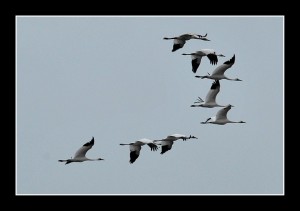By Chester McConnell, Whooping Crane Conservation Association
Whooping cranes are on the move southward and have been spotted all along the migration pathway. The Whooping Crane Conservation Association has received reports of cranes along their migratory path from Saskatchewan, Canada to Aransas, Texas.
Martha C. Tacha, U.S. Fish and Wildlife Service, Nebraska reports that, “The whooping cranes with GPS transmitters are on the move, with the bulk of these marked cranes in North Dakota and South Dakota, and two already in Texas. We know that one unmarked whooper stopped over at a lake near Oklahoma City recently. While the early confirmed sightings have been single birds, there was a group of nine adult-plumaged whoopers in northern North Dakota recently.”
One of the GPS transmitter marked whooping crane arrived on the Texas coast on October 18 and has been using the marsh habitat extensively. Aransas National Wildlife Refuge officials report that, “All other GPS marked whooping cranes are north of South Dakota awaiting favorable migration conditions. Biologists expect the cranes will take advantage of the strong north winds associated with seasonal cold fronts. On October 23 Aransas Refuge Biologist Brad Strobel and Refuge Manager Dan Alonso observed one adult whooping crane feeding in the refuge marshes on the Blackjack peninsula. The bird ate at least two prey items during the 3-5 minutes it was observed.
The winter home of the whooping cranes at Aransas Refuge is improved compared to this time last year. Refuge personnel advise that salinity levels in the bay waters are fresher than they were at this time last fall and winter. The salinity levels in San Antonio Bay were recorded as 23.9 parts per thousand.
Aransas Refuge also has experienced improved rainfall in recent months. According to refuge officials, to date, the refuge has received 25.6 inches of rain, which is a foot more than we had last winter at this time. The area is still unusually dry but the National Oceanic and Atmospheric Administration predicts south Texas will see a wetter than average winter and spring in 2013. To make certain freshwater is available to the whooping cranes when they arrive, refuge staff have been working on water well sites previously used by cranes on the Blackjack peninsula to ensure they are in good working condition.
Whooper food sources on the refuge have also improved during this growing season. Refuge biologists have noticed many flowering and budding wolfberry plants while conducting field work during the last few weeks. Wolfberry conditions in the marsh appear to be much better than this time last year. Peak berry abundance typically occurs in November and December and the plants seem to be on schedule according to biologists. Blue crabs also appear to be abundant in the marsh currently based on surveys conducted by refuge personnel.


